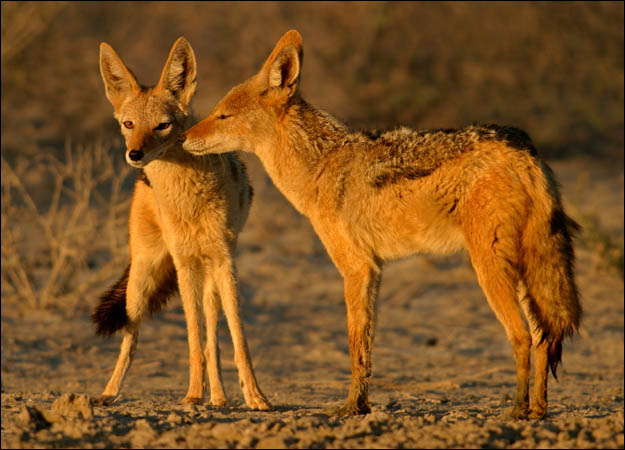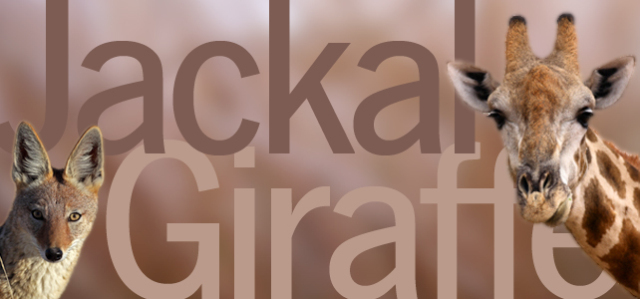
I feel sad when people use animals as metaphors or attribute human qualities to them without knowing much about the real animals. When I hear that someone ‘eats like a pig’ or is a ‘sly fox’, I want to defend the pigs and foxes, even though I concede that pigs can be noisy eaters and foxes are actually rather cunning, because this is blatantly a projection of human concepts onto the animals and an unfairly partial description of their qualities. But when it comes to Marshall Rosenberg’s ‘giraffes’ and ‘jackals’, the characterization is more than unfair, it’s verging on the absurd, as I hope to convince you in this article.
If you have seen NVC videos, you will know that Rosenberg – and many other NVC trainers copying his teaching style – have used giraffe and jackal glove puppets to great effect to demonstrate the ‘right’ and ‘wrong’ ways to communicate. ‘Giraffe’ language is compassionate, sensitive and respectful, while ‘Jackal’ (or in most of Europe, ‘Wolf’) language is judgmental, angry or violent. NVC stores also sell ‘giraffe ears’ and ‘jackal ears’ which are used to role play ‘listening with empathy and compassion’ versus ‘reacting with judgment and criticism’. Well, let’s leave on one side the question of how come a communication system which is supposedly based on NOT classifying behaviour as ‘good’ or ‘bad’, ‘right’ or ‘wrong’, finds it OK to use precisely those concepts as long as they are dressed up in animal metaphors! After all, puppets are fun, I agree. But please, if we’re going to be crude and two-dimensional about this, let’s at least pick stereotypes which fit!
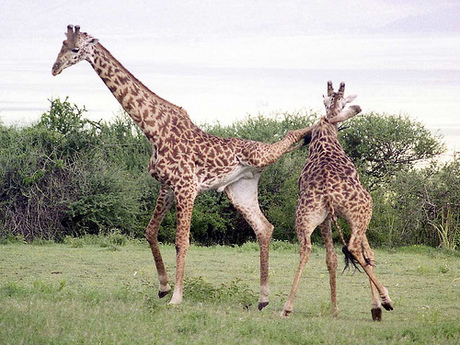 Marshall’s quoted justification for idealising the giraffe is that it has a long neck so it can ‘see far’, and a big heart, so it is full of love, apparently. I didn’t hear why he chose the jackals as the fall guys, the ones who are mean and nasty.
Marshall’s quoted justification for idealising the giraffe is that it has a long neck so it can ‘see far’, and a big heart, so it is full of love, apparently. I didn’t hear why he chose the jackals as the fall guys, the ones who are mean and nasty.
Let’s look at the biological facts first, anyway. Darwin thought that giraffes had long necks so they could eat acacia shoots from the tops of the trees. We know now that this is at best a secondary factor. They mostly feed at a height of about 2m, and more often than not have to bend down to reach their food. The real reason giraffes have long necks is to hurt each other. Even to kill each other. Yes, you read that right!
Giraffes have a tough life, like most wild animals, and they do constantly have to defend themselves and their young against serious predators such as lions and hyenas. They do this by kicking out with their feet, and they pack a deadly kick. They’re not above attacking another giraffe in the same way.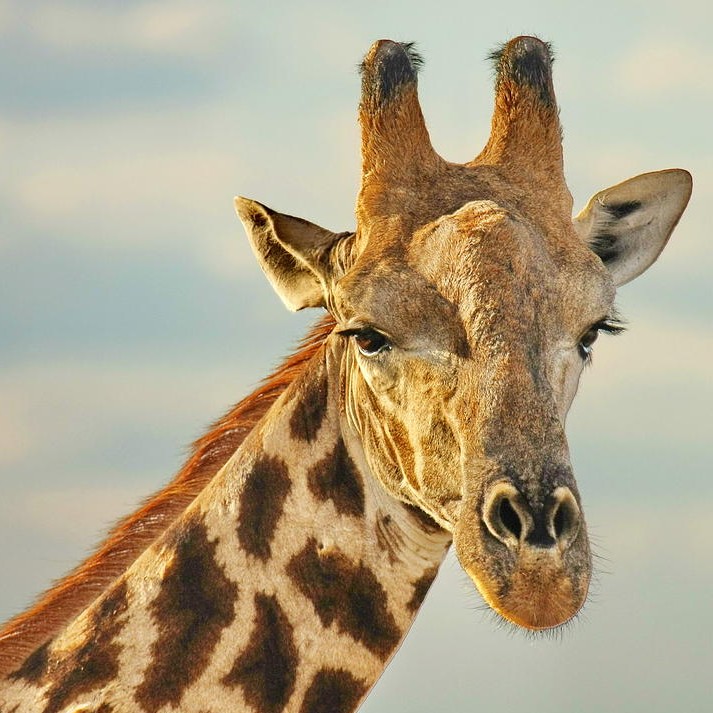 But the giraffe’s weapon of choice when confronting its fellows is actually its 2.5m long neck – and it’s the only animal on Earth possessing such a weapon. On the end of that neck there is a small head concealing a tiny brain, and attached to the top of the specially armoured skull is a pair of bony knobs called the ossicones. These are the equivalent of horns or antlers, except that other animals with horns and antlers use them in trials of strength, or simply as a warning display of virility, without actually making contact with the flesh of the opponent. Whereas the sole purpose of the ossicones in giraffes is to inflict actual bodily harm on their rivals, when they swing their necks like rubberised battering rams at each other.
But the giraffe’s weapon of choice when confronting its fellows is actually its 2.5m long neck – and it’s the only animal on Earth possessing such a weapon. On the end of that neck there is a small head concealing a tiny brain, and attached to the top of the specially armoured skull is a pair of bony knobs called the ossicones. These are the equivalent of horns or antlers, except that other animals with horns and antlers use them in trials of strength, or simply as a warning display of virility, without actually making contact with the flesh of the opponent. Whereas the sole purpose of the ossicones in giraffes is to inflict actual bodily harm on their rivals, when they swing their necks like rubberised battering rams at each other.
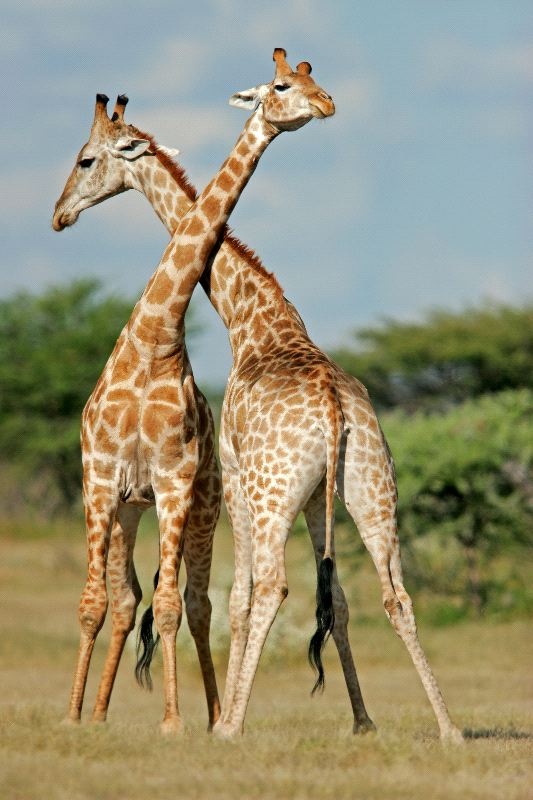
Two males necking. Bizarrely, this image and similar ones of giraffes sizing each other up for a fight have been used by NVC trainers to promote the idea of loving cuddly giraffes!
Male giraffes have various fighting strategies. At first, they size each other up, typically by a sort of giraffe arm-wrestling known as ‘necking’: placing their necks against each other and pushing. Unlike smarter animals which avoid actually coming to blows once they have seen who is the stronger, giraffes more often than not continue to battle regardless, even when it is obvious which one will win (almost always the older and larger one with the longer neck). They proceed to flail backward and forwards with their great necks, hitting mostly against the neck and chest of their opponents, but always attempting to catch their opponent off balance and to land a blow with their ossicones on the vital organs in his belly. You have to watch one of the videos on youtube to see the incredible force and speed they do this with, but be warned, it’s not pretty.
If the loser gives up before he is badly injured, the victor will often mount him in a display of his sexual superiority.
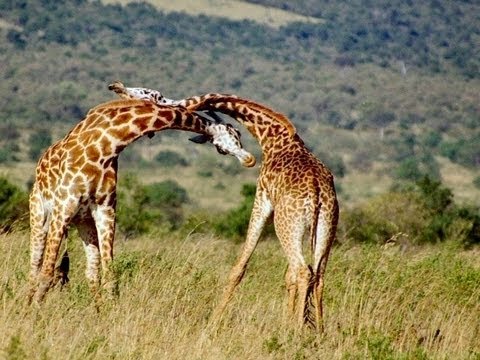 But if the junior animal is weakened but too stubborn to concede, as is often the case, the stronger one will batter him repeatedly until he collapses, sometimes lifting him off the ground with the force of his blows. The winner may even carry on beating him up when the loser is down, and literally batter him to death. That’s right, the emblem of love and compassion, the gentle giraffe whose images adorn every NVC trainer’s publicity material, is a natural born killer!
But if the junior animal is weakened but too stubborn to concede, as is often the case, the stronger one will batter him repeatedly until he collapses, sometimes lifting him off the ground with the force of his blows. The winner may even carry on beating him up when the loser is down, and literally batter him to death. That’s right, the emblem of love and compassion, the gentle giraffe whose images adorn every NVC trainer’s publicity material, is a natural born killer!
And that big heart, the symbol of unconditional love for NVCers world-wide? The mammalian heart is of course the organ that pumps the blood around the body, and the giraffe’s has evolved to be big for one simple reason: it has to pump blood a very long way to keep that tiny brain ticking over 5m above the ground, especially while its head is being used as a battering ram. Even so, a street-fighting giraffe knows that a blow to the back of the neck can cut that blood flow and administer an instant knock-out. Watch it happen at 3m50s into this video. So much for the big love!
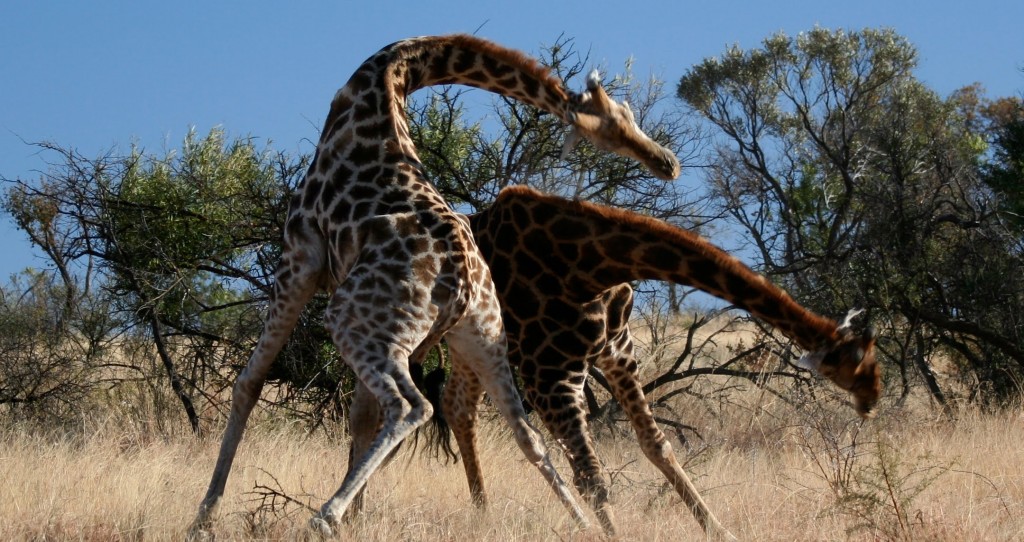 Did you guess why the male giraffes are fighting, by the way? It’s the usual story in an animal species where sexual selection is based on a male dominance hierarchy. The biggest and toughest male gets to have sex with the most females. All of them, actually. By fighting off rivals, the strongest male establishes a breeding territory of dozens of square miles and mates with all of the females in his harem when they come into oestrus. The other males have to wander off on their own and try again next year. 10 years may pass before any of the survivors has a reasonable chance of displacing the dominant bull, but most will live and die without reproducing.
Did you guess why the male giraffes are fighting, by the way? It’s the usual story in an animal species where sexual selection is based on a male dominance hierarchy. The biggest and toughest male gets to have sex with the most females. All of them, actually. By fighting off rivals, the strongest male establishes a breeding territory of dozens of square miles and mates with all of the females in his harem when they come into oestrus. The other males have to wander off on their own and try again next year. 10 years may pass before any of the survivors has a reasonable chance of displacing the dominant bull, but most will live and die without reproducing.
The females, of course, have absolutely no choice in the matter at all and all of them exist merely to service the dominant bull. And this system is doomed to continue down the generations, as the only calves which can be born will carry the dominant male’s genes for the longest, heaviest battering ram he can support and the most aggressive temperament with which to employ it.
Outside the breeding season, giraffes are often solitary, and the herds which do form are loosely structured and constantly changing. Apart from the bond between an unweaned calf and its mother, there is little evidence of any real social cohesion or enduring relationships, let alone of communication skills or ’empathic’ behaviour.
Overall, it’s hard to imagine a less appropriate animal than the giraffe to symbolise compassionate communication, empathy and non-violence. But what then of the giraffe’s shadow side, the much maligned jackal?
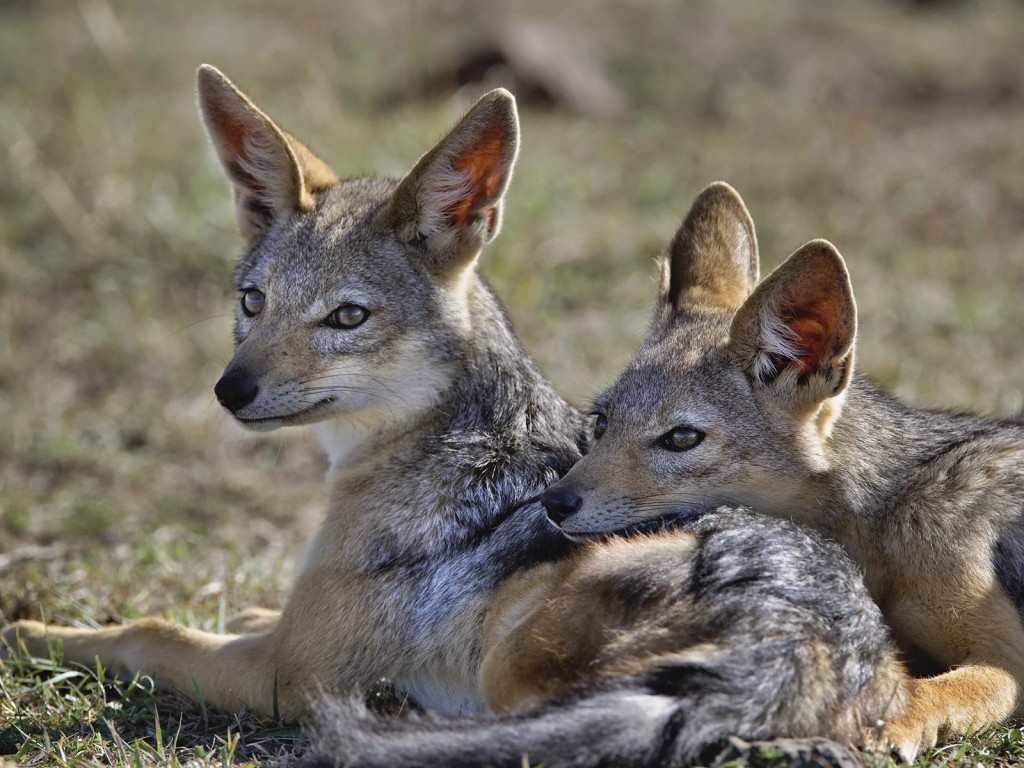 Well, jackals and their coyote-wolf cousins are highly intelligent, social animals.
Well, jackals and their coyote-wolf cousins are highly intelligent, social animals.
They pair-bond for life and both parents assist in caring for the cubs. Families are closely knit and older siblings will also help to feed and babysit new pups.
Jackals are talkative animals, communicating constantly with a variety of yelps, yips and yowls.
They’re also extraordinarily versatile and know how to meet their needs for sustenance in a huge range of environments, adapting to local food resources by eating all kinds of small animals but also a lot of fruit, berries, nuts and mushrooms.
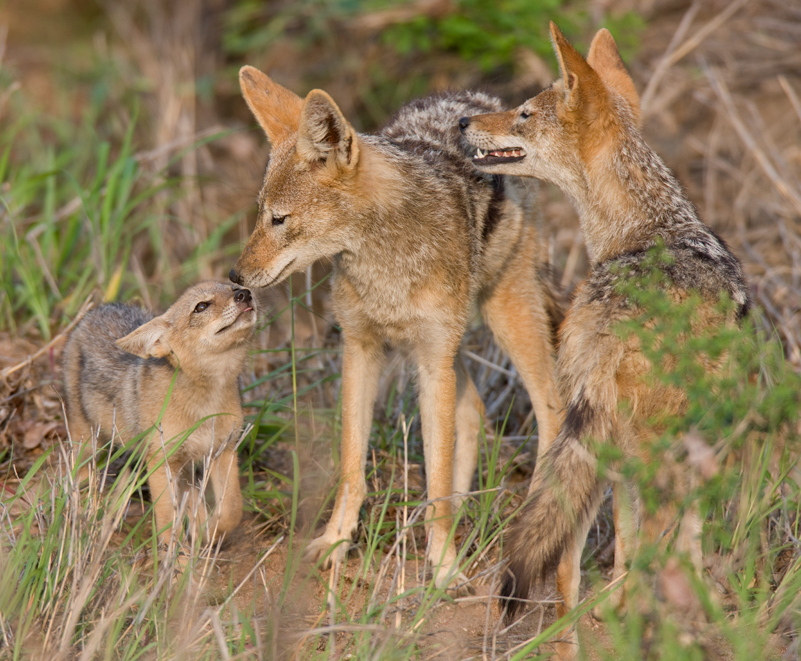
They can hunt singly, in pairs or in small packs according to what prey animals are around. Not only are they intelligent enough to hunt cooperatively, they are such good communicators that they are even known to form commensal alliances with other animals, ranging from wild dogs right up to tigers. And, let’s be honest, they’re much cuter than giraffes!
Yep, Marshall got his African animals really mixed up, so let’s swap them round and make the Jackals the good guys and the Giraffes the baddies! Or maybe we could just pension off the puppets and drop the whole anthropomorphising game of animal metaphors altogether….?!
